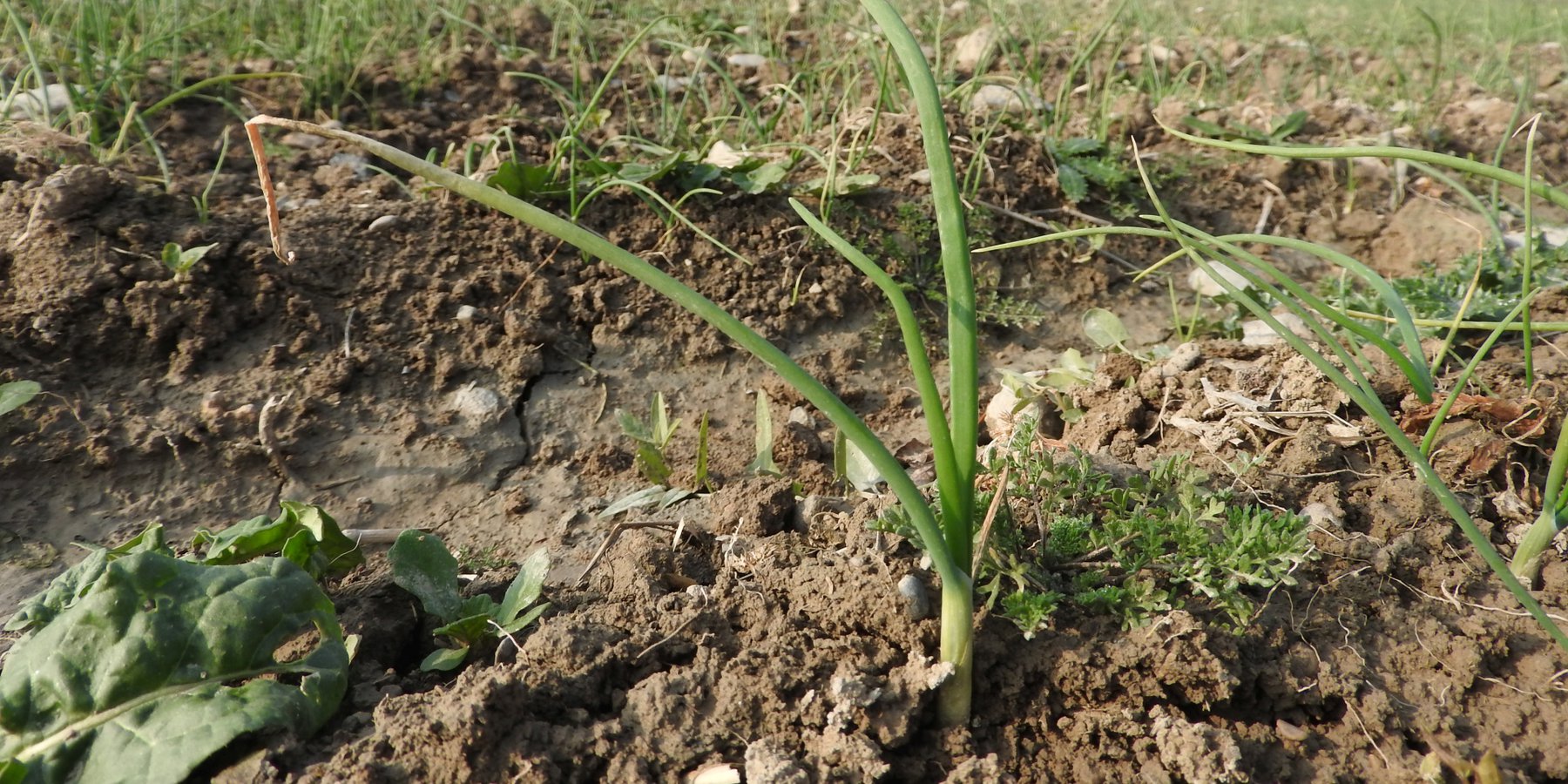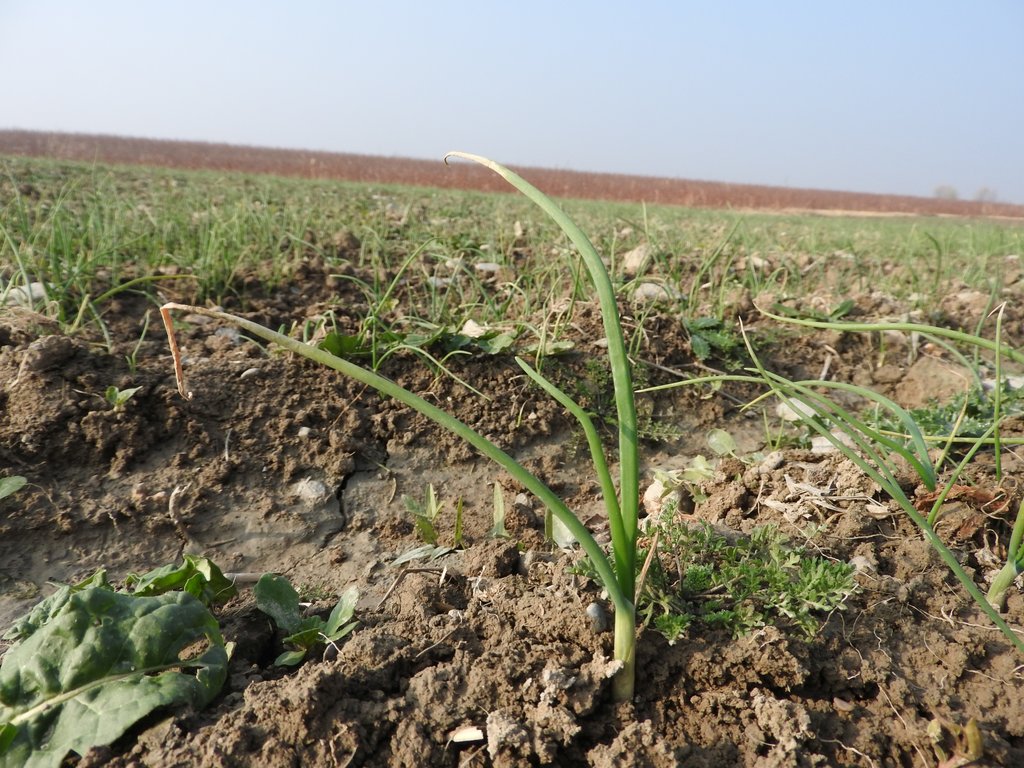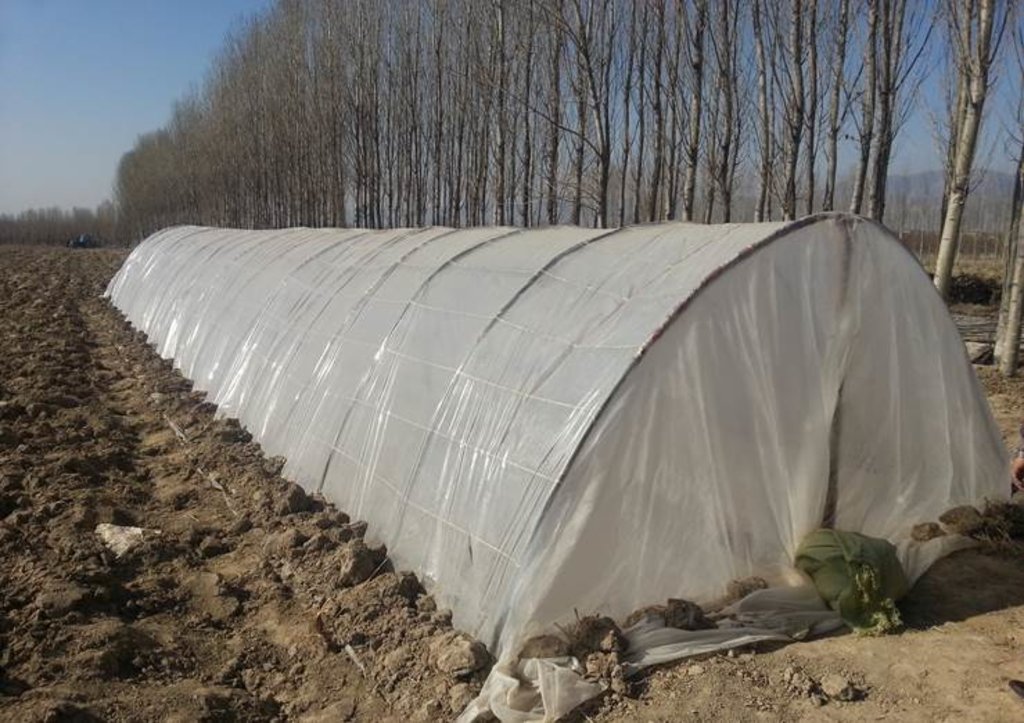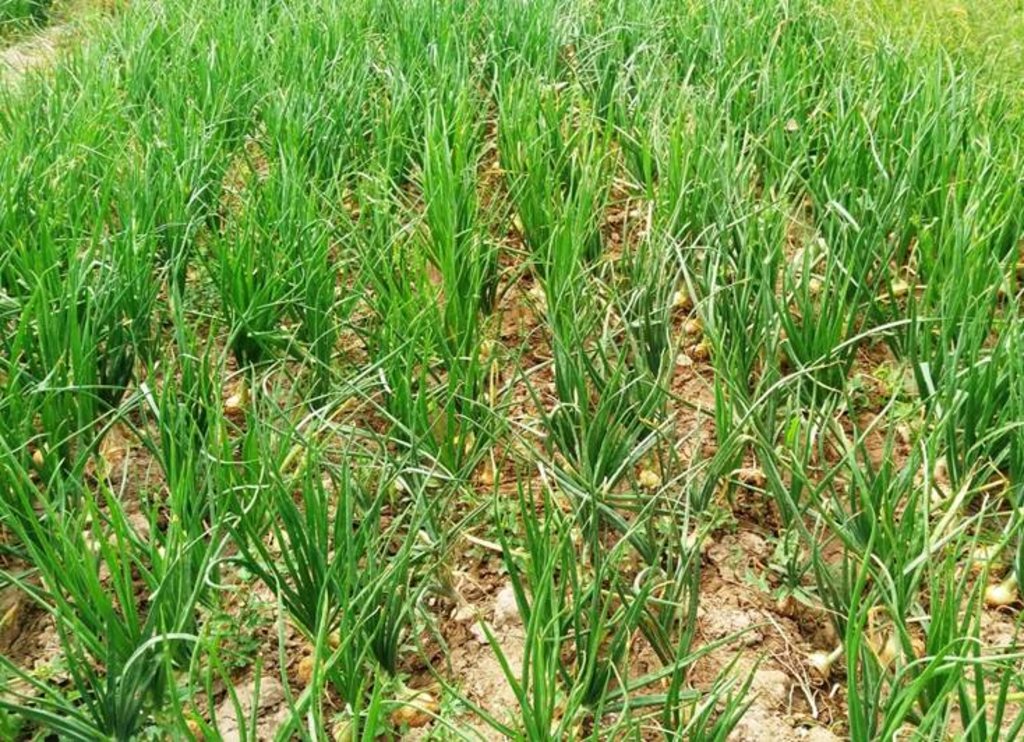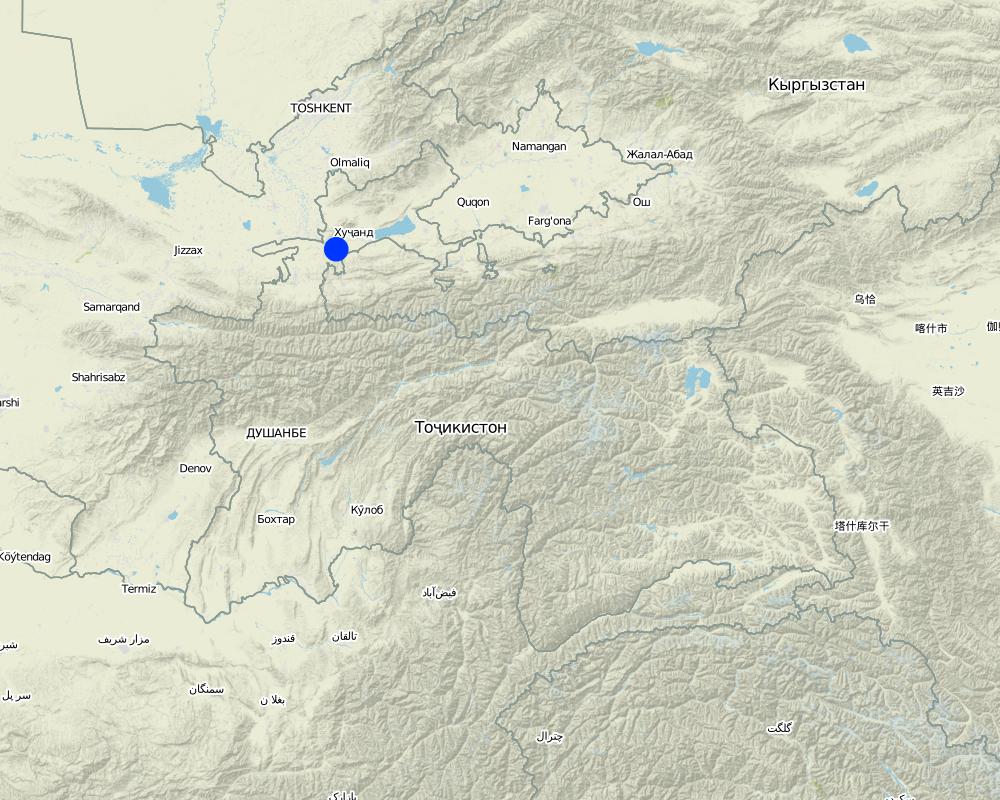Onion production by greenhouse propagation and transplantation [ทาจิกิสถาน]
- ผู้สร้างสรรค์:
- การอัพเดท:
- ผู้รวบรวม: Stefan Michel
- ผู้เรียบเรียง: –
- ผู้ตรวจสอบ: Umed Vahobov
Выращивание лука рассадным способом
technologies_4296 - ทาจิกิสถาน
ดูส่วนย่อย
ขยายทั้งหมด ย่อทั้งหมด1. ข้อมูลทั่วไป
1.2 รายละเอียดที่ติดต่อได้ของผู้รวบรวมและองค์กรที่เกี่ยวข้องในการประเมินและการจัดเตรียมทำเอกสารของเทคโนโลยี
วิทยากรหลัก
ผู้เชี่ยวชาญ SLM:
Negmatov Negmatjon
Deutsche Gesellschaft für Internationale Zusammenarbeit (GIZ)
ทาจิกิสถาน
ผู้เชี่ยวชาญ SLM:
Haydarov Abdusattor
NGO Neksigol
ทาจิกิสถาน
ชื่อของโครงการซึ่งอำนวยความสะดวกในการทำเอกสารหรือการประเมินเทคโนโลยี (ถ้าเกี่ยวข้อง)
Strengthening of Livelihoods through Climate Change Adaptation in Kyrgyzstan and Tajikistanชื่อขององค์กรซึ่งอำนวยความสะดวกในการทำเอกสารหรือการประเมินเทคโนโลยี (ถ้าเกี่ยวข้อง)
Deutsche Gesellschaft für Internationale Zusammenarbeit - Tajikistan (GIZ Tajikistan) - ทาจิกิสถาน1.3 เงื่อนไขการใช้ข้อมูลที่ได้บันทึกผ่านทาง WOCAT
ผู้รวบรวมและวิทยากรหลักยอมรับเงื่อนไขเกี่ยวกับการใช้ข้อมูลที่ถูกบันทึกผ่านทาง WOCAT:
ใช่
1.4 การเปิดเผยเรื่องความยั่งยืนของเทคโนโลยีที่ได้อธิบายไว้
เทคโนโลยีที่ได้อธิบายไว้นี้เป็นปัญหาของความเสื่อมโทรมโทรมของที่ดินหรือไม่ จึงไม่ได้รับการยอมรับว่าเป็นเทคโนโลยีเพื่อการจัดการที่ดินอย่างยั่งยืน:
ไม่ใช่
1.5 Reference to Questionnaire(s) on SLM Approaches (documented using WOCAT)
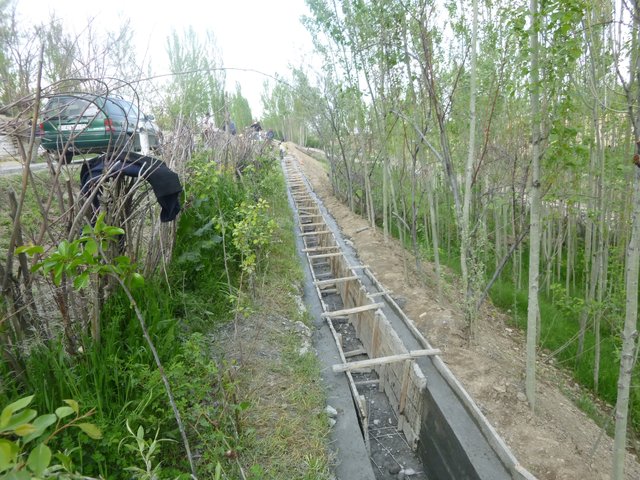
Increased efficiency of irrigation water use to address … [ทาจิกิสถาน]
Climate change impact contributes to irrigation water shortage. The approach of improving irrigation water delivery, distribution and use prevents irrigation water losses and increases the productivity per amount of irrigation water available.
- ผู้รวบรวม: Stefan Michel
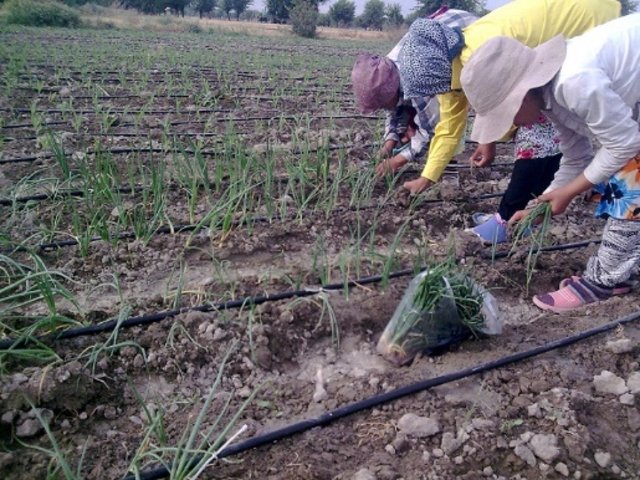
Integrated farming on irrigated lands for adaptation to … [ทาจิกิสถาน]
Irrigated agriculture faces challenges from climate change impact and growing competition for irrigation water. The approach to get "more crop per drop" reduces the adverse effect of these impacts and improves the income of farmers.
- ผู้รวบรวม: Stefan Michel
2. การอธิบายลักษณะของเทคโนโลยี SLM
2.1 การอธิบายแบบสั้น ๆ ของเทคโนโลยี
คำจำกัดความของเทคโนโลยี:
Onion seeds are sown in sheeting greenhouses, where the onion seedlings are propagated. The seedlings are then replanted in the open field. This makes them less prone to extreme weather events and provides higher yield of better quality.
2.2 การอธิบายแบบละเอียดของเทคโนโลยี
คำอธิบาย:
The technology of greenhouse propagation of onion plants and transplantation is applied in intensive, irrigation dependent agricultural systems. The technology is based on sowing of onion seeds in a sheeting greenhouse, where the seedlings grow for 45 days. Afterwards the onion seedlings are replanted in the open field. By this technology the sensitive seedlings are propagated in a protective environment making them less vulnerable to unfavorable weather conditions, like late freezing or rainstorms. Due to ongoing climate change weather conditions become less predictable and extreme events become more frequent.
The propagation of onions in the greenhouse requires substantially less seeds than traditional hand sowing in the field – 4 kg/ha onion field instead of 16-18 kg, i.e. saving 75-77%. Furthermore the propagation of onion seedlings in greenhouses with transplanting allows for a reduced input of pesticides and fertilizer compared to sowing in the field. This reduction of agrochemical input is related to the small area and favorable conditions in the greenhouse during the propagation of the seedlings.
The technology requires the preparation of the field in fall with 30 cm deep ploughing, harrowing and planning (молование). Afterwards the furrows for planting are made. Complex mineral fertilizer “NitroAmmoPhosKa” (N 16%, P2O5 16%, K2O 16%) or “DiAmmoPhosKa” (N 16%, P 16%, K 16%) in an amount of 75 kg per ha is applied before the transplanting.
The onion seeds are in mid-March sown in a sheeting greenhouse with 4 kg seeds on 100 m². Together with the seeds 3 kg “NitroAmmoPhosKa” and some dung are applied as fertilizer. After 45 days the onion seedlings have reached the stage of three real leaves and are in their optimum growth stage for replanting into the field. The seedlings in the three-leaf stage are by hand planted on the open ground of the prepared as described field.
During the growth period the seedlings are one time weeded and fertilized as follows: i) during planting 75 kg/ha “NitroAmmoPhosKa” is applied; ii) another 100 kg/ha “NitroAmmoPhosKa” is applied in form of supplementary fertilizing (подкормка). Also other fertilizer has been applied in form of supplementary fertilizing (подкормка) 400 kg/ha “Selitra”, 200 kg/ha “Ammophos” and 200 kg/ha “Karbamid (46)”. The onion has also been treated with various pesticides. The field is 10 times irrigated during the vegetation season, requiring 8000 m³ of irrigation water.
The yield on test plots was 91,300 kg/ha. The harvested onions are more homogenous in size thus better marketable than those propagated conventionally.
The benefit of the technology is the reduced amount of seeds required, reduced costs of pesticides and fertilizer. Despite the costs of materials and the effort needed to establish the greenhouse and the additional work for transplanting the seedlings, the technology provides an economic net benefit to the farmer. In testing plots the net profit of traditional onion cultivation was 76% while with greenhouse propagation and transplanting a net profit of 192% would be achieved. Greenhouse propagation also protects the seedlings from failure caused by extreme weather events, which become more frequent due to climate change, and thus reduce the risk for the farmers.
2.3 รูปภาพของเทคโนโลยี
2.5 ประเทศภูมิภาค หรือสถานที่ตั้งที่เทคโนโลยีได้นำไปใช้และได้รับการครอบคลุมโดยการประเมินนี้
ประเทศ:
ทาจิกิสถาน
ภูมิภาค/รัฐ/จังหวัด:
Sughd region
ข้อมูลจำเพาะเพิ่มเติมของสถานที่ตั้ง :
J. Rasulov district
ระบุการกระจายตัวของเทคโนโลยี:
- ใช้ ณ จุดที่เฉพาะเจาะจงหรือเน้นไปยังบริเวณพื้นที่ขนาดเล็ก
Is/are the technology site(s) located in a permanently protected area?
ไม่ใช่
แสดงความคิดเห็น:
So far only single farmers apply the technology.
Map
×2.6 วันที่การดำเนินการ
ระบุปีที่ใช้:
2016
2.7 คำแนะนำของเทคโนโลยี
ให้ระบุว่าเทคโนโลยีถูกแนะนำเข้ามาอย่างไร:
- ในช่วงการทดลองหรือการทำวิจัย
- ทางโครงการหรือจากภายนอก
ความคิดเห็น (ประเภทของโครงการ เป็นต้น) :
Demonstration plots have been established and monitored by the NGO Neksigol with support by the GIZ project.
3. การจัดประเภทของเทคโนโลยี SLM
3.1 วัตถุประสงค์หลักของเทคโนโลยี
- ปรับปรุงการผลิตให้ดีขึ้น
- ปรับตัวเข้ากับการเปลี่ยนแปลงภูมิอากาศของโลก สภาพภูมิอากาศที่รุนแรงและผลกระทบ
- สร้างผลกระทบทางด้านเศรษฐกิจที่เป็นประโยชน์
3.2 ประเภทของการใช้ที่ดินในปัจจุบันที่ได้นำเทคโนโลยีไปใช้
Land use mixed within the same land unit:
ไม่ใช่

พื้นที่ปลูกพืช
- การปลูกพืชล้มลุกอายุปีเดียว
Annual cropping - Specify crops:
- cereals - wheat (spring)
- fibre crops - cotton
- oilseed crops - sunflower, rapeseed, other
- vegetables - root vegetables (carrots, onions, beet, other)
จำนวนของฤดูเพาะปลูกต่อปี:
- 1
Is crop rotation practiced?
ใช่
3.3 Has land use changed due to the implementation of the Technology?
Has land use changed due to the implementation of the Technology?
- No (Continue with question 3.4)
3.4 การใช้น้ำ
การใช้น้ำของที่ดินที่มีการใช้เทคโนโลยีอยู่:
- การชลประทานแบบเต็มรูปแบบ
3.5 กลุ่ม SLM ที่ตรงกับเทคโนโลยีนี้
- การปรับปรุงพันธุ์พืชหรือพันธุ์สัตว์ต่าง ๆ
- imoroved vegetable cultivation
3.6 มาตรการ SLM ที่ประกอบกันเป็นเทคโนโลยี

มาตรการจัดการพืช
- A5: การจัดการเมล็ดพันธุ์ การปรับปรุงพันธุ์
- A7: Others
3.8 การป้องกัน การลดลง หรือการฟื้นฟูความเสื่อมโทรมของที่ดิน
ระบุเป้าหมายของเทคโนโลยีกับความเสื่อมโทรมของที่ดิน:
- ไม่สามารถใช้ได้
4. ข้อมูลจำเพาะด้านเทคนิค กิจกรรมการนำไปปฏิบัติใช้ ปัจจัยนำเข้า และค่าใช้จ่าย
4.2 ข้อมูลทั่วไปเกี่ยวกับการคำนวณปัจจัยนำเข้าและค่าใช้จ่าย
ให้ระบุว่าค่าใช้จ่ายและปัจจัยนำเข้าได้รับการคำนวณอย่างไร:
- ต่อพื้นที่ที่ใช้เทคโนโลยี
ระบุขนาดและหน่วยพื้นที่:
hectare
อื่นๆ หรือสกุลเงินประจำชาติ (ระบุ):
TJS
If relevant, indicate exchange rate from USD to local currency (e.g. 1 USD = 79.9 Brazilian Real): 1 USD =:
8.0
ระบุค่าเฉลี่ยของค่าจ้างในการจ้างแรงงานต่อวัน:
20-50
4.4 ค่าใช้จ่ายของปัจจัยนำเข้าที่จำเป็นสำหรับการจัดตั้ง
แสดงความคิดเห็น:
We did not differentiate establishment and recurrent activities, as this is a technology to be integrated in the overall cycle of agricultural works.
4.5 การบำรุงรักษาสภาพหรือกิจกรรมที่เกิดขึ้นเป็นประจำ
| กิจกรรม | ช่วงระยะเวลา/ความถี่ | |
|---|---|---|
| 1. | Preparation of greenhouse field (100 m²) | February-March/once per annum |
| 2. | Establishment of sheeting greenhouse | February-March/once per annum |
| 3. | Sowing onion seeds and care | March-April/once per annum |
| 4. | Transplanting of seedlings | End April/once per annum |
| 5. | Ploughing of field, harrowing, planning, making furrows | Before transplanting/once per annum |
| 6. | Fertilizing | Before transplanting, during vegetation |
| 7. | Irrigation | 10 times during vegetation season |
| 8. | Application of pesticides | 5 times during vegetation season |
| 9. | Weeding | 3 times during vegetation season |
| 10. | Harvest | Once per annum |
แสดงความคิดเห็น:
We did not differentiate establishment and recurrent activities, as this is a technology to be integrated in the overall cycle of agricultural works.
4.6 ค่าใช้จ่ายของปัจจัยนำเข้าและกิจกรรมที่เกิดขึ้นเป็นประจำที่ต้องการการบำรุงรักษา (ต่อปี)
| ปัจจัยนำเข้า | หน่วย | ปริมาณ | ค่าใช้จ่ายต่อหน่วย | ค่าใช้จ่ายทั้งหมดต่อปัจจัยนำเข้า | %ของค่าใช้จ่ายที่ก่อให้เกิดขึ้นโดยผู้ใช้ที่ดิน | |
|---|---|---|---|---|---|---|
| แรงงาน | Preparation of greenhouse field (100 m²) | person | 1.0 | 50.0 | 50.0 | 100.0 |
| แรงงาน | Establishment of greenhouse | person | 1.0 | 50.0 | 50.0 | 100.0 |
| แรงงาน | Sowing onion seeds and care (over 45 days) | person | 2.0 | 50.0 | 100.0 | 100.0 |
| แรงงาน | Agrotechnical works | ha | 1.0 | 820.0 | 820.0 | 100.0 |
| อุปกรณ์ | Sheeting | m | 50.0 | 1.0 | 50.0 | 100.0 |
| วัสดุด้านพืช | Seeds | kg | 4.0 | 685.0 | 2740.0 | 100.0 |
| วัสดุด้านพืช | Transplanting | 1.0 | 1520.0 | 1520.0 | 100.0 | |
| ปุ๋ยและสารฆ่า/ยับยั้งการเจริญเติบโตของสิ่งมีชีวิต (ไบโอไซด์) | Politrin ka | l | 1.0 | 200.0 | 200.0 | 100.0 |
| ปุ๋ยและสารฆ่า/ยับยั้งการเจริญเติบโตของสิ่งมีชีวิต (ไบโอไซด์) | Mospilan | kg | 0.4 | 100.0 | 40.0 | 100.0 |
| ปุ๋ยและสารฆ่า/ยับยั้งการเจริญเติบโตของสิ่งมีชีวิต (ไบโอไซด์) | Goal | l | 0.6 | 220.0 | 132.0 | 100.0 |
| ปุ๋ยและสารฆ่า/ยับยั้งการเจริญเติบโตของสิ่งมีชีวิต (ไบโอไซด์) | Other pesticides | Total | 1.0 | 2371.0 | 2371.0 | 100.0 |
| ปุ๋ยและสารฆ่า/ยับยั้งการเจริญเติบโตของสิ่งมีชีวิต (ไบโอไซด์) | Ammonium Nitrate | 50 kg | 8.0 | 120.0 | 960.0 | 100.0 |
| ปุ๋ยและสารฆ่า/ยับยั้งการเจริญเติบโตของสิ่งมีชีวิต (ไบโอไซด์) | NitroAmmoPhosKa | 50 kg | 4.8 | 240.0 | 1152.0 | 100.0 |
| ปุ๋ยและสารฆ่า/ยับยั้งการเจริญเติบโตของสิ่งมีชีวิต (ไบโอไซด์) | Ammophos | 50 kg | 4.0 | 160.0 | 640.0 | 100.0 |
| ปุ๋ยและสารฆ่า/ยับยั้งการเจริญเติบโตของสิ่งมีชีวิต (ไบโอไซด์) | Karbamid (46) | 50 kg | 4.0 | 130.0 | 520.0 | 100.0 |
| วัสดุสำหรับก่อสร้าง | 2.0 | |||||
| อื่น ๆ | Irrigation | times | 10.0 | 50.0 | 500.0 | 100.0 |
| อื่น ๆ | Irrigation water | m³ | 8000.0 | 0.018 | 144.0 | 100.0 |
| อื่น ๆ | Application of pesticides | times | 5.0 | 50.0 | 250.0 | 100.0 |
| อื่น ๆ | Weeding | times | 3.0 | 500.0 | 1500.0 | 100.0 |
| อื่น ๆ | Harvest | ha | 1.0 | 4000.0 | 4000.0 | 100.0 |
| อื่น ๆ | Miscellaneous expenses | 1.0 | 1000.0 | 1000.0 | 100.0 | |
| ค่าใช้จ่ายทั้งหมดของการบำรุงรักษาสภาพเทคโนโลยี | 18739.0 | |||||
| Total costs for maintenance of the Technology in USD | 2342.38 | |||||
แสดงความคิดเห็น:
We did not differentiate establishment and recurrent activities, as this is a technology to be integrated in the overall cycle of agricultural works.
4.7 ปัจจัยสำคัญที่สุดที่มีผลกระทบต่อค่าใช้จ่าย
ปัจจัยสำคัญที่สุดที่มีผลกระทบต่อค่าใช้จ่ายต่างๆ:
Transplanting is an important additional cost factor, compared to conventional sowing. However, costs for seeds is lower despite of use of higher quality seeds of certified sorts.
5. สิ่งแวดล้อมทางธรรมชาติและของมนุษย์
5.1 ภูมิอากาศ
ฝนประจำปี
- < 250 ม.ม.
- 251-500 ม.ม.
- 501-750 ม.ม.
- 751-1,000 ม.ม.
- 1,001-1,500 ม.ม.
- 1,501-2,000 ม.ม.
- 2,001-3,000 ม.ม.
- 3,001-4,000 ม.ม.
- > 4,000 ม.ม.
ระบุปริมาณน้ำฝนเฉลี่ยรายปี (ถ้ารู้) :หน่วย ม.ม.
246.00
ระบุชื่อของสถานีตรวดวัดอากาศที่ใช้อ้างอิงคือ:
Mehrobod
เขตภูมิอากาศเกษตร
- กึ่งแห้งแล้ง
5.2 สภาพภูมิประเทศ
ค่าเฉลี่ยความลาดชัน:
- ราบเรียบ (0-2%)
- ลาดที่ไม่ชัน (3-5%)
- ปานกลาง (6-10%)
- เป็นลูกคลื่น (11-15%)
- เป็นเนิน (16-30%)
- ชัน (31-60%)
- ชันมาก (>60%)
ธรณีสัณฐาน:
- ที่ราบสูง/ที่ราบ
- สันเขา
- ไหล่เขา
- ไหล่เนินเขา
- ตีนเนิน
- หุบเขา
ระดับความสูง:
- 0-100 เมตร
- 101-500 เมตร
- 501-1,000 เมตร
- 1,001-1,500 เมตร
- 1,501-2,000 เมตร
- 2,001-2,500 เมตร
- 2,501-3,000 เมตร
- 3,001-4,000 เมตร
- > 4,000 เมตร
ให้ระบุถ้าเทคโนโลยีได้ถูกนำไปใช้:
- ไม่เกี่ยวข้อง
5.3 ดิน
ค่าเฉลี่ยความลึกของดิน:
- ตื้นมาก (0-20 ซ.ม.)
- ตื้น (21-50 ซ.ม.)
- ลึกปานกลาง (51-80 ซ.ม.)
- ลึก (81-120 ซ.ม.)
- ลึกมาก (>120 ซ.ม.)
เนื้อดิน (ดินชั้นบน):
- ปานกลาง (ดินร่วน ทรายแป้ง)
เนื้อดินล่าง (> 20 ซ.ม.ต่ำจากผิวดิน):
- ปานกลาง (ดินร่วน ทรายแป้ง)
อินทรียวัตถุในดิน:
- ปานกลาง (1-3%)
5.4 ความเป็นประโยชน์และคุณภาพของน้ำ
ระดับน้ำใต้ดิน:
<5 เมตร
น้ำไหลบ่าที่ผิวดิน:
ปานกลาง
คุณภาพน้ำ (ที่ยังไม่ได้บำบัด):
เป็นน้ำใช้เพื่อการเกษตรเท่านั้น (การชลประทาน)
Water quality refers to:
both ground and surface water
ความเค็มของน้ำเป็นปัญหาหรือไม่:
ไม่ใช่
กำลังเกิดน้ำท่วมในพื้นที่หรือไม่:
ไม่ใช่
5.5 ความหลากหลายทางชีวภาพ
ความหลากหลายทางชนิดพันธุ์:
- ต่ำ
ความหลากหลายของแหล่งที่อยู่:
- ต่ำ
5.6 ลักษณะของผู้ใช้ที่ดินที่นำเทคโนโลยีไปปฏิบัติใช้
อยู่กับที่หรือเร่ร่อน:
- อยู่กับที่
แนวทางการตลาดของระบบการผลิต:
- ทำการค้า/การตลาด
ระดับของความมั่งคั่งโดยเปรียบเทียบ:
- พอมีพอกิน
เป็นรายบุคคล/ครัวเรือน:
- เป็นรายบุคคล/ครัวเรือน
- สหกรณ์
ระดับของการใช้เครื่องจักรกล:
- การใช้เครื่องจักรหรือเครื่องยนต์
เพศ:
- หญิง
- ชาย
อายุของผู้ใช้ที่ดิน:
- ผู้เยาว์
- วัยกลางคน
5.7 Average area of land used by land users applying the Technology
- < 0.5 เฮกตาร์
- 0.5-1 เฮกตาร์
- 1-2 เฮกตาร์
- 2-5 เฮกตาร์
- 5-15 เฮกตาร์
- 15-50 เฮกตาร์
- 50-100 เฮกตาร์
- 100-500 เฮกตาร์
- 500-1,000 เฮกตาร์
- 1,000-10,000 เฮกตาร์
- >10,000 เฮกตาร์
พิจารณาว่าเป็นขนาดเล็ก กลาง หรือขนาดใหญ่ (ซึ่งอ้างอิงถึงบริบทระดับท้องถิ่น):
- ขนาดกลาง
แสดงความคิดเห็น:
Technology can be applied by small-holders as well as by large farms.
5.8 กรรมสิทธิ์ในที่ดิน สิทธิในการใช้ที่ดินและสิทธิในการใช้น้ำ
กรรมสิทธิ์ในที่ดิน:
- รัฐ
สิทธิในการใช้ที่ดิน:
- เช่า
- Water management organization
Are land use rights based on a traditional legal system?
ไม่ใช่
5.9 การเข้าถึงบริการและโครงสร้างพื้นฐาน
สุขภาพ:
- จน
- ปานกลาง
- ดี
การศึกษา:
- จน
- ปานกลาง
- ดี
ความช่วยเหลือทางด้านเทคนิค:
- จน
- ปานกลาง
- ดี
การจ้างงาน (เช่น ภายนอกฟาร์ม):
- จน
- ปานกลาง
- ดี
ตลาด:
- จน
- ปานกลาง
- ดี
พลังงาน:
- จน
- ปานกลาง
- ดี
ถนนและการขนส่ง:
- จน
- ปานกลาง
- ดี
น้ำดื่มและการสุขาภิบาล:
- จน
- ปานกลาง
- ดี
บริการด้านการเงิน:
- จน
- ปานกลาง
- ดี
6. ผลกระทบและสรุปคำบอกกล่าว
6.1 ผลกระทบในพื้นที่ดำเนินการ (On-site) จากการใช้เทคโนโลยี
ผลกระทบทางด้านเศรษฐกิจและสังคม
การผลิต
การผลิตพืชผล
จำนวนก่อน SLM:
40.000 kg/ha
หลังจาก SLM:
91,300 kg/ha
คุณภาพพืชผล
แสดงความคิดเห็น/ระบุ:
Higher percentage of onions of standard size and quality
รายได้และค่าใช้จ่าย
ค่าใช่จ่ายของปัจจัยการผลิตทางการเกษตร
แสดงความคิดเห็น/ระบุ:
Reduction of fertilizer application: by 50% (400 kg) Ammonium Nitrate and 52% (260 kg) NitroAmmoPhosKa
รายได้จากฟาร์ม
จำนวนก่อน SLM:
14,266 TJS/ha
หลังจาก SLM:
36.041 TJS/ha
แสดงความคิดเห็น/ระบุ:
The net profit while applying this technololgy is 192% of the costs, compared with 76% with applying conventional methods.
ผลกระทบด้านนิเวศวิทยา
ผลกระทบด้านนิเวศวิทยาอื่น ๆ
Onion seedlings less prone to extreme weather events, like late freezing and snow
6.3 การเผชิญและความตอบสนองของเทคโนโลยีต่อการเปลี่ยนแปลงสภาพภูมิอากาศที่ค่อยเป็นค่อยไป และสภาพรุนแรงของภูมิอากาศ / ภัยพิบัติ (ที่รับรู้ได้โดยผู้ใช้ที่ดิน)
สภาพรุนแรงของภูมิอากาศ (ภัยพิบัติ)
ภัยพิบัติทางอุตุนิยมวิทยา
| เทคโนโลยีมีวิธีการรับมืออย่างไร | |
|---|---|
| พายุฝนประจำท้องถิ่น | ดี |
| พายุหิมะประจำท้องถิ่น | ดี |
| พายุลมประจำท้องถิ่น | ไม่ค่อยดี |
ภัยพิบัติจากสภาพภูมิอากาศ
| เทคโนโลยีมีวิธีการรับมืออย่างไร | |
|---|---|
| คลื่นความหนาว | ดีมาก |
6.4 การวิเคราะห์ค่าใช้จ่ายและผลประโยชน์ที่ได้รับ
ผลประโยชน์ที่ได้รับเปรียบเทียบกับค่าใช้จ่ายในการจัดตั้งเป็นอย่างไร (จากมุมมองของผู้ใช้ที่ดิน)
ผลตอบแทนระยะสั้น:
ด้านบวก
ผลตอบแทนระยะยาว:
ด้านบวก
ผลประโยชน์ที่ได้รับเปรียบเทียบกับค่าใช้จ่ายในการบำรุงรักษาหรือต้นทุนที่เกิดขึ้นซ้ำอีก เป็นอย่างไร (จากมุมมองของผู้ใช้ที่ดิน)
ผลตอบแทนระยะสั้น:
ด้านบวก
ผลตอบแทนระยะยาว:
ด้านบวก
6.5 การปรับตัวของเทคโนโลยี
- 1-10%
Of all those who have adopted the Technology, how many did so spontaneously, i.e. without receiving any material incentives/ payments?
- 91-100%
6.6 การปรับตัว
เทคโนโลยีได้รับการปรับเปลี่ยนเมื่อเร็วๆนี้ เพื่อให้ปรับตัวเข้ากับสภาพที่กำลังเปลี่ยนแปลงหรือไม่:
ไม่ใช่
6.7 จุดแข็ง / ข้อได้เปรียบ / โอกาสของเทคโนโลยี
| จุดแข็ง / ข้อได้เปรียบ / โอกาสในทัศนคติของผู้รวบรวมหรือวิทยากรหลัก |
|---|
| Reduced risk, reduced amount of seeds |
| Increased yield of better quality |
| As onion is an important crop in the area there is high potential for the application of the technology |
6.8 จุดอ่อน / ข้อเสียเปรียบ / ความเสี่ยงของเทคโนโลยีและวิธีการแก้ไข
| จุดอ่อน / ข้อเสียเปรียบ / ความเสี่ยงในทัศนคติของผู้รวบรวมหรือวิทยากรหลัก | มีวิธีการแก้ไขได้อย่างไร |
|---|---|
| None | |
| High workload required for transplanting | Adequate organization of farm works. Attraction of temporary labor. |
| Sheeting of greenhouses only suitable for one season, no recycling opportunities - risk of massive littering of the environment. | Establishment of system for collection of used sheeting and its recycling or energetic use. |
7. การอ้างอิงและการเชื่อมต่อ
7.1 วิธีการและแหล่งข้อมูล
- ไปเยี่ยมชมภาคสนาม การสำรวจพื้นที่ภาคสนาม
- การสัมภาษณ์ผู้เชี่ยวชาญด้าน SLM หรือผู้ชำนาญ
- การเก็บรวบรวมมาจากรายงานและเอกสารที่มีอยู่
Documentation by the project: information sheet, excel files for calculation of gross margin specifying inputs and yield.
วันที่เก็บรวบรวมข้อมูล(ภาคสนาม) :
29/11/2018
ลิงก์และโมดูล
ขยายทั้งหมด ย่อทั้งหมดลิงก์

Increased efficiency of irrigation water use to address … [ทาจิกิสถาน]
Climate change impact contributes to irrigation water shortage. The approach of improving irrigation water delivery, distribution and use prevents irrigation water losses and increases the productivity per amount of irrigation water available.
- ผู้รวบรวม: Stefan Michel

Integrated farming on irrigated lands for adaptation to … [ทาจิกิสถาน]
Irrigated agriculture faces challenges from climate change impact and growing competition for irrigation water. The approach to get "more crop per drop" reduces the adverse effect of these impacts and improves the income of farmers.
- ผู้รวบรวม: Stefan Michel
โมดูล
ไม่มีโมดูล


